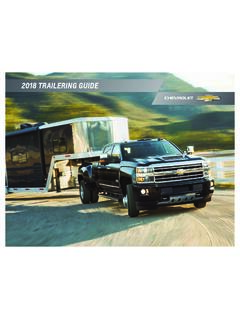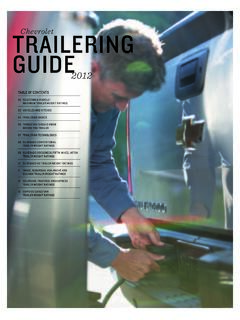Transcription of Your Guide to ABS and EBS - Transports Friend
1 Your Guide toABS and EBS updated September 2003 Produced by VOSA Technical ServicesSwanseaSeptember 20033 Vehicle and Trailer ABS and EBSI ndexSection 1 Introduction Section 2 Introduction to ABS. Anti-lock Braking Systems Section 3 Introduction to EBS. Electronic Braking Systems Section 4 General Statement of Operation Section 5 Electrical Connections between Vehicle and Trailer Section 6 Annual Test Quick Reference Guide for Trailers Section 7 HGV Inspection Manual ABS Information Sheet Section 8 Reference Table for Vehicle Warning Lamps Section 9 Trailer EBS Manufacturers Information Sheets Section 10 General Information for Buses Section 11 Questions and Answers Section 12 Advisory Note for Drivers4581011151621293536404 Introduction to the Anti-Lock and Electronic Braking GuideThe aim of the document is to give enough information for all involved in inspecting vehicles andtrailers to be able to understand and apply a uniform standard of has been a difficult document to compile and we know that some will think it does not
2 Go far enoughand some will think it is too technical. This is our second attempt based on comments which havebeen received from numerous sources. I would like to take this opportunity to thank all those who havecontributed. We would welcome any feedback on this Guide which will assist us in keeping it up Guide is not the end, as developments are ongoing we will endeavour to keep this supply ofinformation as up to date as you send any comments to: on the VOSA address book if using Lotus PattisonSection 15 Introduction to ABSThe abbreviation ABS stands for anti-lock braking system. The purpose of this system is to prevent thewheels from locking when the brakes are applied when the brake force generated exceeds that whichcan be transmitted to the road via the great benefit with the ABS system is that it provides a maximum exploitation of the available roadsurface friction when the brakes are applied.
3 Consequently the braking distance is considerably shorterand the vehicle is much easier to control under emergency the vehicle is pulling a trailer the most efficient conditions are when both the tractor and trailer areequipped with non-locking ABS system is governed by a control unit (micro-computer) which senses the wheel speeds withthe aid of a sensor and a pole wheel or exciter ring fitted to the brake drum or disc. The signals fromthe sensor are processed by the control unit, which, via solenoid valves, governs the braking pressureof the individual wheel brake actuators. Where axles form a bogie, it may only have sensors fitted toone of the axles forming the bogie. The ABS system includes a number of control functions that testthe individual electrical circuits to ensure that they are functioning correctly.
4 Should a fault occur thedriver is informed by a warning lamp on his instrument panel or, if a trailer is being drawn, via a lampvisible to the driver on the front of the of ABST owing VehiclesCategory 1 The ABS will operate on at least one front axle and on one rear axle and have the abilityto utilise the higher adhesion when braking on a split friction surface. This will require oneof the axles, usually the rear axle, to have independent control. A typical system wouldhave four sensors and four modulators but could effectively have four sensors and 2 or 3modulators. In the latter case the front axle could use one modulator with a Select Low control philosophy where modulation action is taken on the first wheel to lock. Thissystem will protect the towing vehicle from brake induced jack-knifing and enable thedriver to steer during braking by preventing the directly controlled wheels from 2 The ABS will operate on at least one front axle and on one rear axle.
5 The system willhave a minimum of four sensors and two modulators (one for each axle). The system willgenerally operate on a select Low control philosophy where modulation action will betaken on the first wheel to lock. This system will protect the towing vehicle from brakeinduced jack-knifing and enable the driver to steer during braking by preventing thedirectly controlled wheels from 3 The ABS operates only on the rear (drive) axle. The system will have two sensors andone modulator and generally a select Low control philosophy where modulation actionwill be taken on the first wheel to lock. This system will protect the towing vehicle frombrake induced jack-knifing by preventing the directly controlled wheels from 26 TrailersCategory AA trailer with a Category A ABS will meet the split friction deceleration requirements.
6 Onlytrailers approved under the carriage of dangerous goods regulations (ADR) must have aCategory A system. The minimum requirement for a Category A semi-trailer would be fortwo sensors and two modulators. Each modulator would control the wheels on one sideof the trailer. The minimum requirement for a Category A full drawbar trailer (a turntabletype) is four sensors and three modulators. In this case the rear axle would beindependently BA trailer with a Category B ABS does not need to meet the split friction decelerationrequirements. The minimum requirement for either a semi-trailer or a centre axle drawbartrailer is two sensors and one modulator. On a full drawbar (turntable type) the minimumrequirement would be two sensors and two modulators, although four sensors and threemodulators is the industry practice.
7 Mandatory ABSType of VehicleDatesCategory RequiredMotor vehicles with design GVW greater than16000kg and authorised to tow a semi-trailer, or acentre axle drawbar trailer, with total design axleweights greater than 10000kgs or a full drawbartrailer (turntable type) with a design GVW greaterthan 10000kgs (an O4 trailer). See examples below First used from 1st April 1992 to 30 April 1 Semi-trailers and centre axle drawbar trailers witha design total axle weight of more than after 1st A or BSemi-trailers and centre axle drawbar trailers witha design total axle weight of more than 10000kgand do not have a load sensing from 1st October1982 to 30th September specific categorySemi-trailers and centre axle drawbar trailers witha design total axle weight of more than 3500kg. Manufactured after 1st May A or BFull drawbar trailers (turntable type) with a designGVW of more than after 1st A or BFull drawbar trailers (turntable type) with a designGVW of more than 10000kg and do not have aload sensing from 1st October1982 to 30th September specific categoryFull drawbar trailers (turntable type) with a designGVW of more than after 1st May A or BAll motor vehicles over 3500kg GVW.
8 Thisincludes Motor Homes based on an N1 from 1st November2001 and first used from the 1stMay specific categoryMotor Homes over 3500kg based on an N1chassis but are designed to meet M1 brakeperformance from1st October1991 and first used from 1st April2002 and greater than 1 Section 2 Exempt vehicles Public works vehicles which have a maximum design GVW of 7500kg and which are speciicallydesigned for and used solely for the purpose of street 1 Semi - Trailer or Rigid and Drawbar Trailer Drawing vehicle GVW 18000kgGTW greater than 28000kg(GTW - GVW > 10000kg)Anti-lock brakes required Example 2 Drawing vehicle GVW 18000kgGTW equal to 28000kg or less(GTW - GVW < 10000kg)Anti lock brakes may be required if:1. The drawing hitch is rated at more than 10000kg, or; 2.
9 The tractor is presented for test with a semi-trailer which has Total AxleWeight summation of greater than 10000kg, or;3. the drawing vehicle is presented for test with a full drawbar trailer (turntabletype) which has a GVW greater than 10000kg. Note:the tow hitch should have a manufacturer s identification plate showing the hitch 28 Introduction to EBSThe abbreviation EBS stands for Electronic Braking System. The purpose of this system is to improvevehicle control, reaction and stability during braking over and above that currently possible from aconventional pneumatic system. This is achieved by using electrical signals to operate pneumaticvalves. A back up system is usually retained in case of an electrical great benefit with EBS is that it can simultaneously fulfil the operation of an anti-lock system (ABS)and a load sensing system with a superior reaction time.
10 If the vehicle is towing an EBS trailer the twosystems can communicate via a data bus and offer the potential of improved tractor/ trailercompatibility. With motor vehicles it can also provide ASR (Anti-Slip Reduction).Manufacturers claim: Reduced combination response times Improved stability under braking Improved compatibility between vehicle and trailer Reduced operating temperatures Reduction in components and pipework Reduced operating costs Improve even brake lining wear on motor vehicles Comprehensive self diagnostic testsMotor Vehicle ECU (Electronic Control Unit)This unit controls and monitors the operation of the EBS. It maybe linked to other electroniccomponents through a CAN (Controlled Area Network) data line. In this way, whenever it receives asignal from the Brake Signal Transmitter, it takes instant and continuous readings from the wheelspeed sensors on the vehicle.

